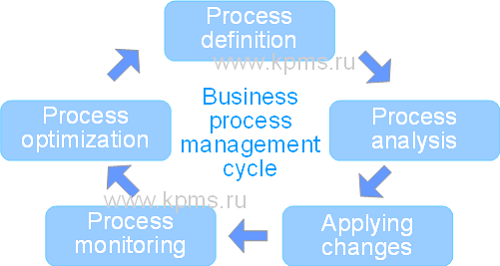Business Process Management is a systematic approach to management aimed at improving the activities of an organization and its processes. This approach makes it possible for an organization to define processes and organize its execution, and also improve the quality of both the results of processes and the order of its execution.
Business process management
A business process is understood as a set of logically interrelated actions or tasks, the execution of which leads to the expected result. Therefore, almost all the processes of the organization can be attributed to business processes.
The main purpose of business process management is to bring processes in accordance with the goals of the organization. Each process must be configured in such a way that the results of the process lead to the achievement of business goals.
Business process management uses the following approaches:
- Comprehensive, understandable and documented standardization of processes, including the creation of a set of standardized processes and the ability to customize them to changing conditions;
- Continuous improvement of processes, including daily monitoring, measurement, analysis and change of processes;
- Application of information technologies and software, including modeling of business processes, application of CASE tools, automation of business processes and their optimization based on information technologies.
Business processes types
Business processes are divided into types depending on the classification feature. Business process management applies to all of them.
Three groups of business processes can be distinguished:
- Management processes. These processes are destined for planning, monitoring and analyzing work. It is possible to guarantee the achievement of goals by production and support processes due to management processes. Management processes do not add value to the end user, but they are necessary for the efficient and effective work of the organization. Such processes often include planning, goal setting, monitoring and measurement, budgeting, etc.
- Production (main) processes. The organization achieves its goals due to these business processes. Production processes transform of a product or provide a service and add value to the end user. Production processes include the processes of design, manufacture, provision of services, installation, etc.
- Supporting processes. These processes are necessary for the normal execution of production processes. They do not add value to the end user, but without them it is impossible to achieve the goals of production processes. The supporting processes include procurement processes, personnel management, infrastructure management, etc.
Business process management cycle
The business process management cycle follows the principles of continuous improvement. Management consists of repetitive stages if based on these principles. Each stage includes several phases. A certain set of actions is performed into each phase. In general, the stages of business process management are similar to the DMAIC cycle of the 6 sigma methodology.
Business process management consists of the following phases:

- The first phase is the definition of the process. The process is simulated in the initial state and in the desired state ("as is" and "as should be" models are developed) at this phase;
- The second phase is the analysis of the process. Various options for the process actions are determined, simulation modeling is carried out at this phase. Optimal methods for improving the business process are determined as a result;
- The third phase is the implementation of changes. The selected improvement methods are applied to the process at this stage. Changes are being implemented in the process;
- The fourth phase is process monitoring. The process is periodically monitored according to certain indicators at this phase;
- The fifth phase is process optimization. The actual results are compared with the desired model ("as should be") and the next improvement cycle begins at this phase.
If the specified phases of business process management need to be applied to several processes, then a preliminary phase is performed. The necessary processes are selected and priorities are set for their change and improvement during the preliminary phase.
